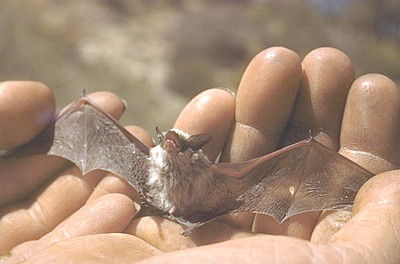IDFG Wildlife Natural Resource Program Coordinator
 |
Improving rabies awareness and preventing human exposure to rabid bats is a public health priority. At the same time, conservation of bats and the benefits they provide is increasingly important due to declining populations of many bat species.
If a bat is found, the first thing to determine is whether the bat had direct contact with people or pets. Bats that have not had contact with humans or pets can be captured and released outside.
Capture the bat without touching it by using a cardboard box or other container, with small air holes. Then slide a folder or piece of cardboard over the opening of the box to secure the bat inside.
Carry it outside, then step back and remove the folder. The bat may not immediately fly away until it becomes familiar with its surroundings. The open box can be left outside and retrieved later.
If a bat is suspected, or known, to have had direct contact with a person or pet, a risk assessment should be done with the Idaho Department of Fish and Game and the Idaho Department of Health and Welfare.
If the risk is deemed high, the bat should be safely captured without touching it with bare hands (you can use leather gloves), and it should be tested for rabies.
Capture a live bat as described above, but instead of releasing it, close and secure the top of the box or container. Then call an Idaho Department of Fish and Game office.
The bat will be humanely euthanized and transferred to the nearest Public Health District for submission to the Idaho Bureau of Laboratories for rabies testing. If the bat is dead, homeowners can contact the nearest Public Health District directly so it can be submitted for testing.
Some inaccurate generalizations about bats and fear that all bats have rabies has resulted in negative perceptions, which can lead to the indiscriminate killing of bats and barriers to bat conservation.
It’s important to clear up some of those common misconceptions. Although bats are primarily nocturnal, they are occasionally active during daylight, so seeing an active bat during the day does not mean it is sick or rabid. This is especially true during late summer and early fall as they prepare to migrate, and when young bats are leaving their maternity colonies for the larger landscape.
Also, bats do not “carry” rabies. Bats, like other mammals, can contract and die from rabies. Across North America, only about 0.1 percent of wild bats have rabies. However, bats are considered a significant wildlife reservoir for rabies across the United States, and they are the only known natural reservoir of rabies in Idaho.
Therefore, human and domestic animal contacting bats should be minimized, and bats should never be handled by untrained and unvaccinated persons, or be kept as pets.
Rabies is 99.9 percent fatal, but 100 percent preventable through prompt, appropriate medical care. People should call their health care provider immediately if they have:
* Been bitten or scratched by a bat.
* When saliva, or other potentially infectious material (such as brain tissue) from a bat has come into contact with an open wound, abrasion, scratch, or mucous membrane.
* Woken up to find a bat in the room.
* Witnessed a bat in the room with a previously unattended child, mentally challenged person, or intoxicated individual.
For exposure of pets to bats, people should call their veterinarian for advice.